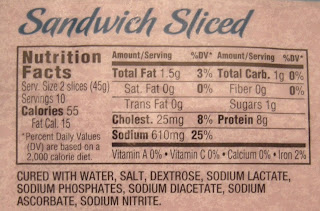Ah darn!! Hoodwinked again….
Well I thought I was doing the right thing and generally speaking I was right. But even right these days comes with a risk analysis involving a risk-reward curve. Honestly, I always knew the ham for my daily ham sandwich was packaged in something but always kicked the can down the road about thinking much about what it might be. Yes, eating low fat ham is a better choice than a lot of choices but my time of reckoning has arrived. Darn it!
“The World Cancer Research Fund (WCRF) has just completed a detailed review of more than 7,000 clinical studies covering links between diet and cancer. Its conclusion is rocking the health world with startling bluntness: Processed meats are too dangerous for human consumption. Consumers should stop buying and eating all processed meat products for the rest of their lives. Processed meats include bacon, sausage, hot dogs, sandwich meat, packaged ham, pepperoni, salami and virtually all red meat used in frozen prepared meals. They are usually manufactured with a carcinogenic ingredient known as sodium nitrite. This is used as a color fixer by meat companies to turn packaged meats a bright red color so they look fresh. Unfortunately, sodium nitrite also results in the formation of cancer-causing nitrosamines in the human body. And this leads to a sharp increase in cancer risk for those who eat them. A 2005 University of Hawaii
My daily processed meat sandwich includes added water, salt and…..
Dextrose is found in high amounts in many common packaged products and baking foods that are high in sugar such as cake mixes and frosting, cookies, crackers and pretzels. Keep in mind that consuming too much of all sugars, including dextrose, has many negative health effects, including suppressing your immune system and impairing your body's defenses against infectious diseases; causing rapid spikes in your blood sugar levels; problems with your gastrointestinal system; and a possible rise in your cholesterol levels.
Sodium lactate is the sodium salt of lactic acid produced by fermentation of a sugar source, such as corn or beets, and then neutralizing the resulting lactic acid[4] to create a compound having the formula NaC3H5O3. As a food additive, sodium lactate has the E number E325 and naturally is a liquid product, but also is available in powder form. As early as 1836, sodium lactate was recognized as a salt of a weak acid rather than being a base, and it was then known that the lactate had to be metabolized in the liver before the sodium could have any titrating activity. Sodium lactate has a mild saline taste. It may be used in shampoo products and other similar items such as liquid soaps as it is an effective moisturizer. Sodium lactate commonly is used to treat arrhythmias caused by overdosing of class I anti-arrythmics, as well as pressor sympathomimetics which can cause hypotension.
Sodium phosphate is a generic term for the salts of sodium hydroxide and phosphoric acid. Sodium phosphates are often used as meat preservatives, as an alternative to sodium nitrite. This is common in canned meats.
Sodium diacetate is a compound with formula NaH(C2H3O2)2. It is a 1:1 mixture of sodium acetate and acetic acid but is also described as the sodium acid salt of acetic acid. It is a common additive in "Salt and Vinegar" flavored chips.
Sodium ascorbate is a more bio-available form of vitamin C that is an alternative to taking ascorbic acid as a supplement. The molecular formula of this chemical compound is C6H7NaO6. As the sodium salt of ascorbic acid (vitamin C), it is known as a mineral ascorbate. As a food additive, it has the E number E301 and is used as an antioxidant and an acidity regulator. It is approved for use as a food additive in the EU, USA and Australia and New Zealand

.jpg)


Comments
Post a Comment